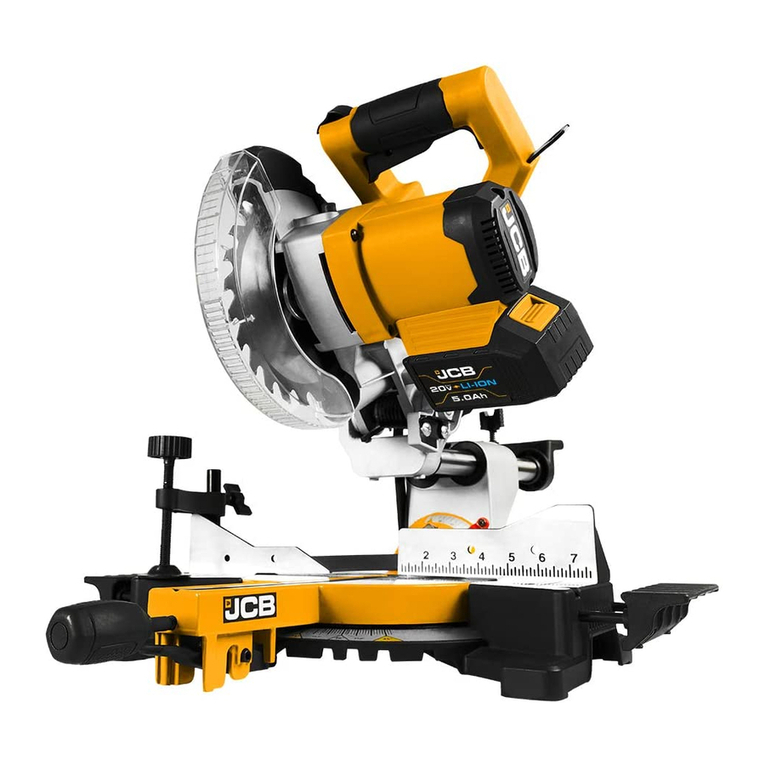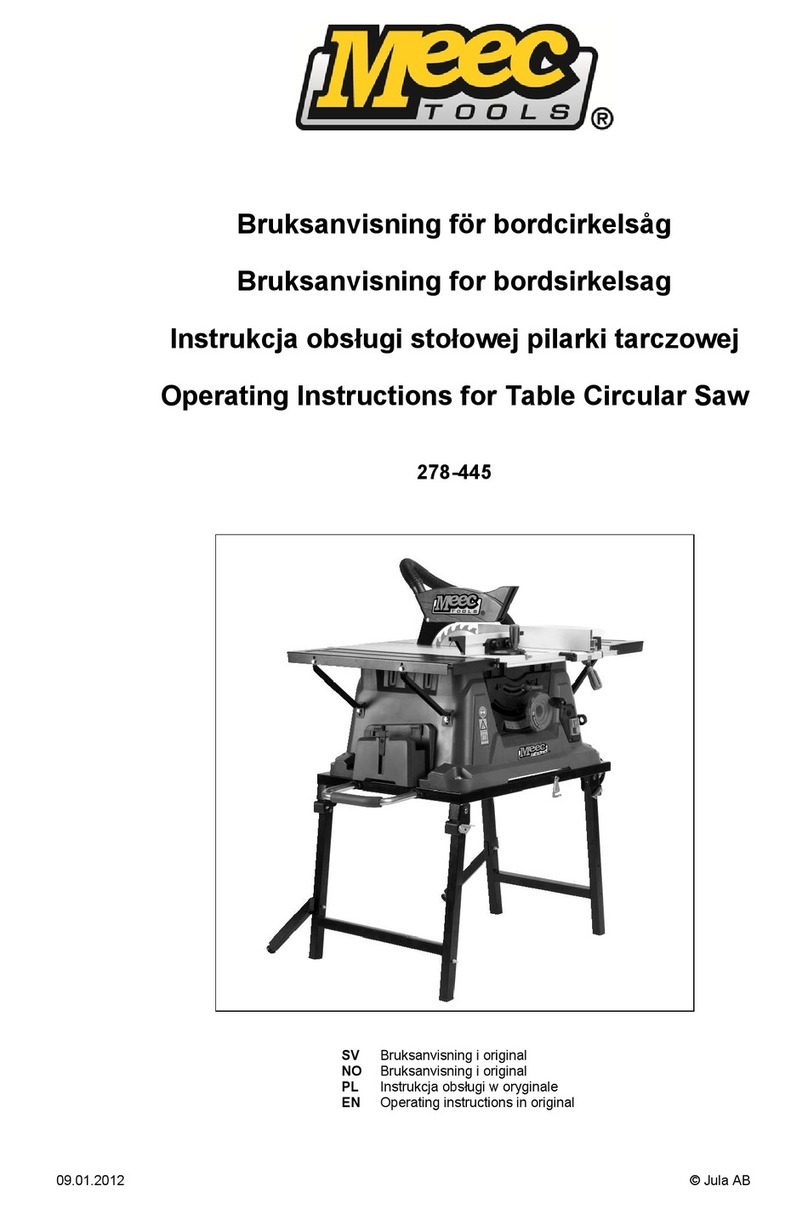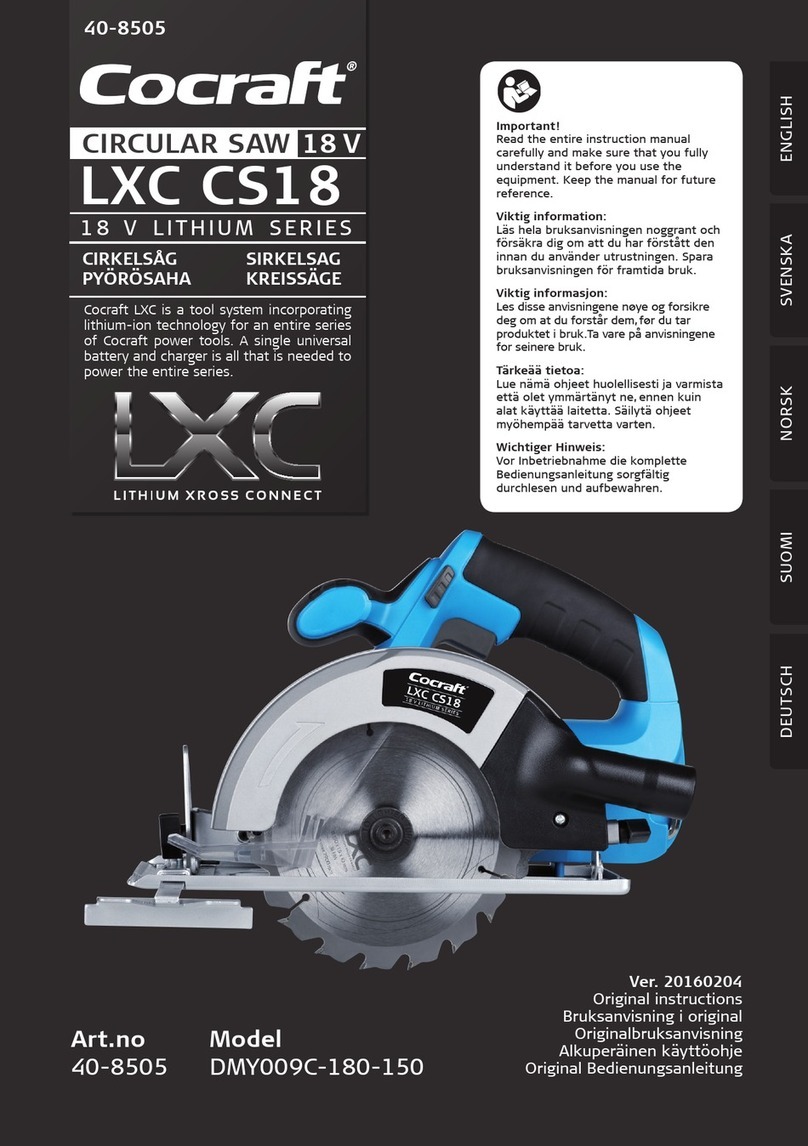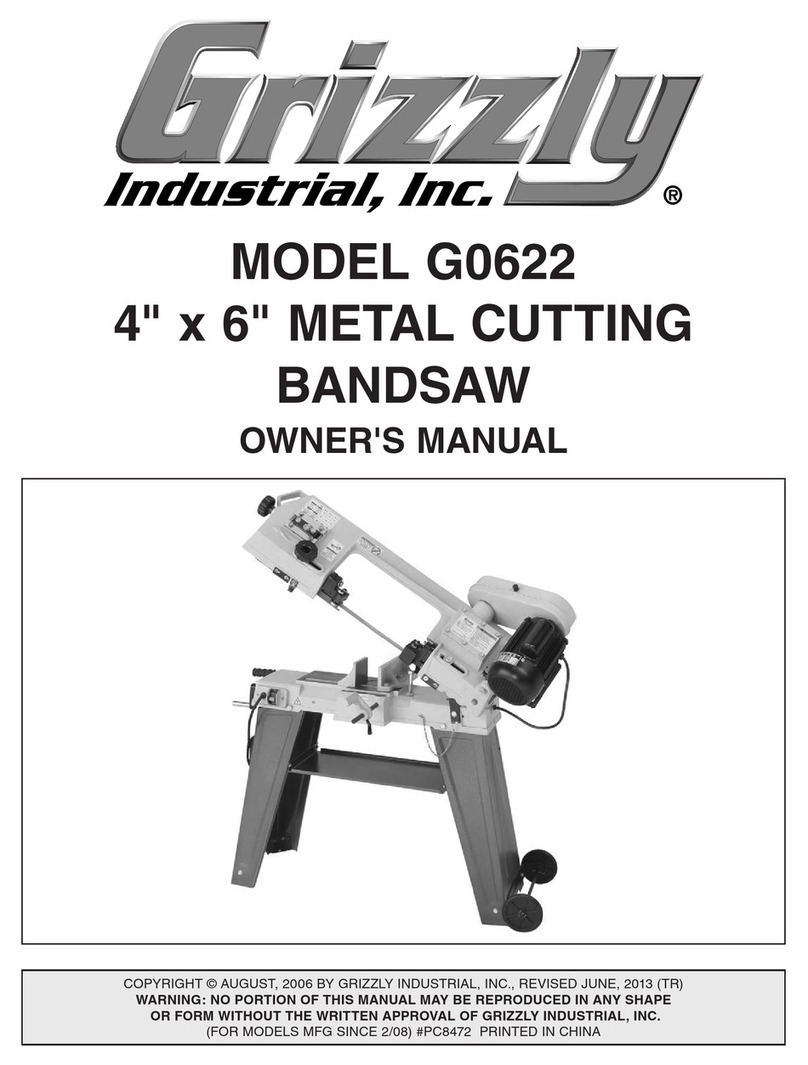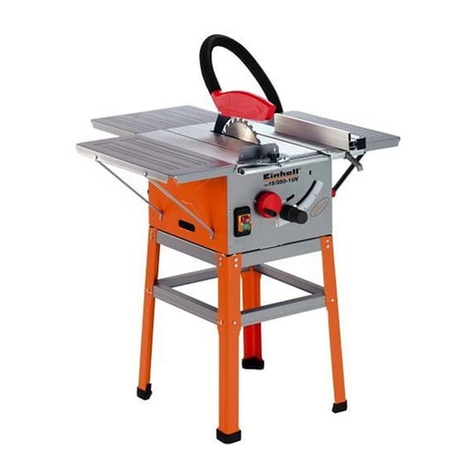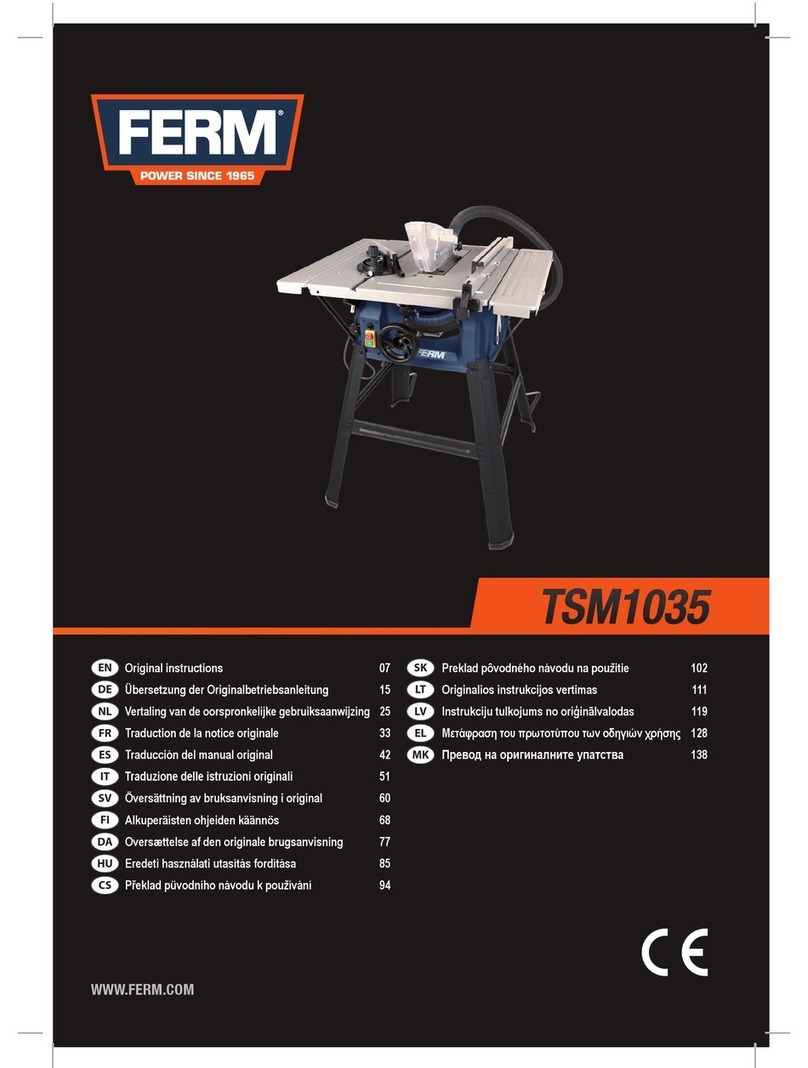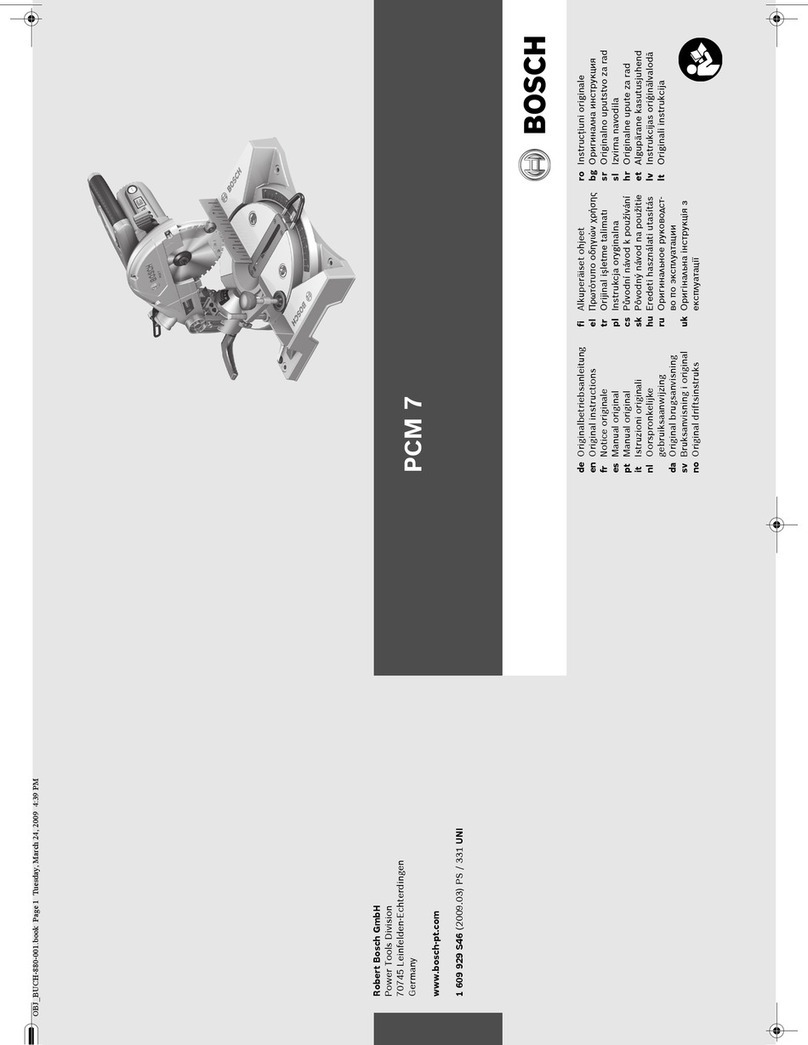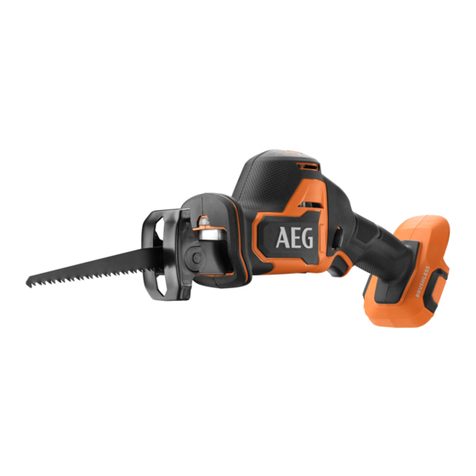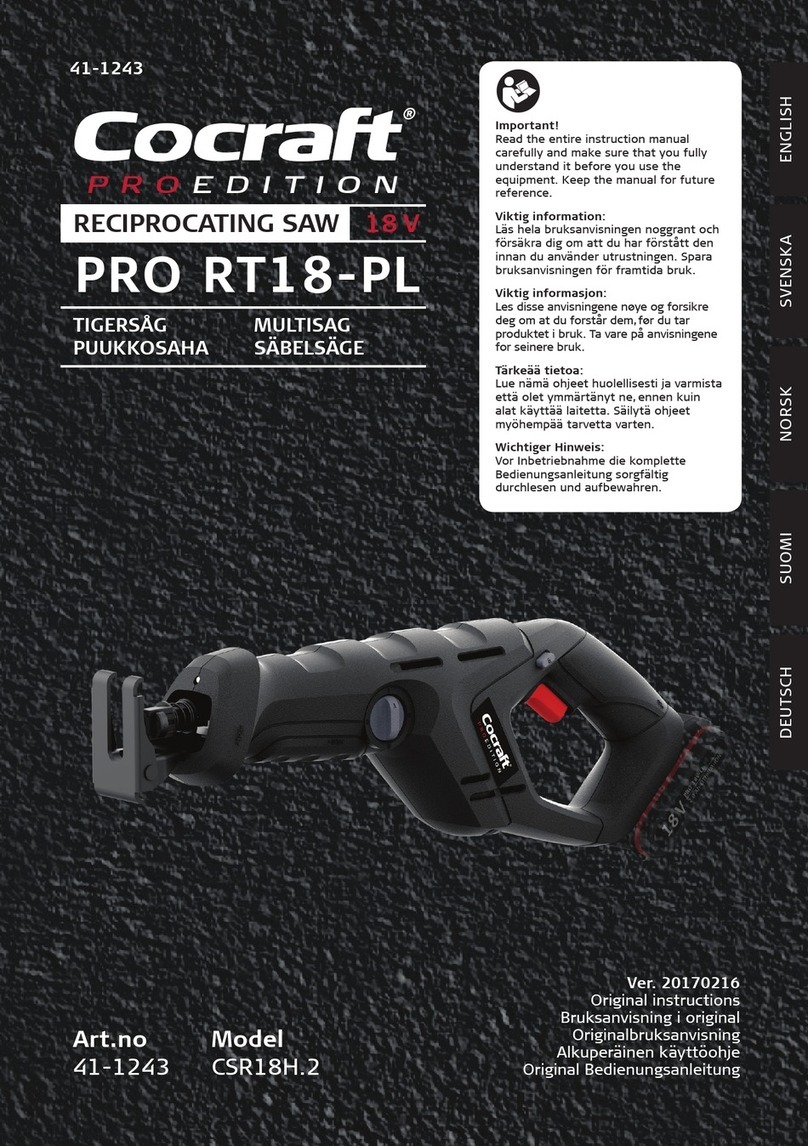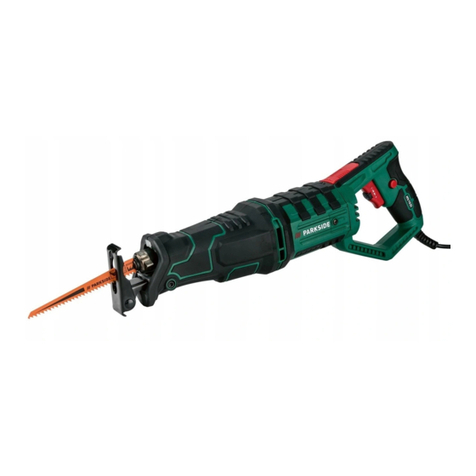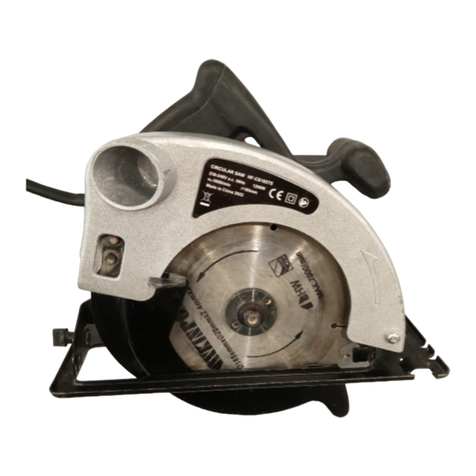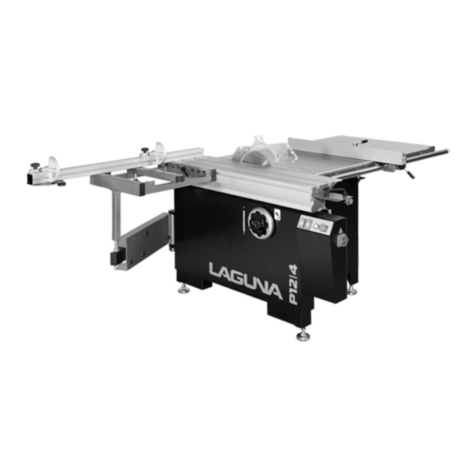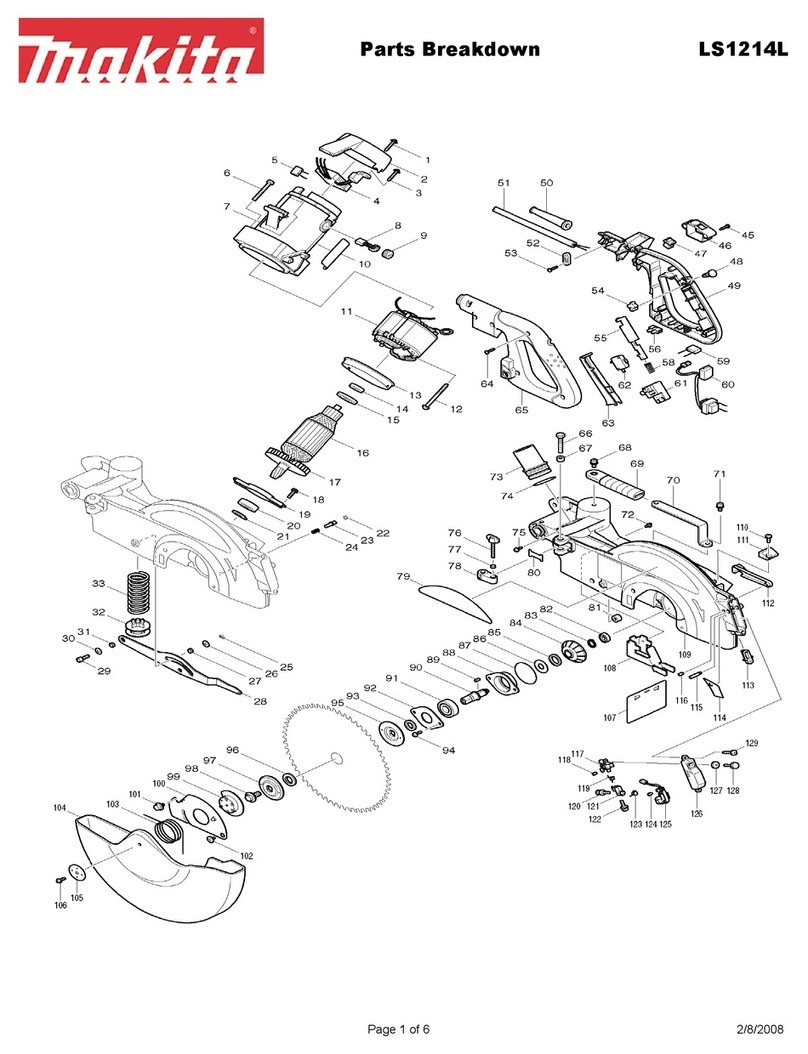GreenTech QD6905LR User manual

MINI CIRCULAR SAW
P 18
Model / Modèle : 02325009
QD6905LR
MINI-SCIE CIRCULAIRE
800-832-7168

ENGLISH
1
8
9
4
65
1b
1a
2
7
14
12
11
13
10
17
3
Overview
1
15b
16
15a
3
7
213
9
12
11
62
4
3
14
5
10
15

ENGLISH
TABLE OF CONTENTS
1. Overview...................................................................................................1
2. Safety Symbols.........................................................................................2
3. Safety Instructions....................................................................................3
5. Application................................................................................................11
4. Technical Data..........................................................................................9
6. Operation..................................................................................................13
7. Maintenance.............................................................................................16
WARNING! Please read all of the safety and operating instructions
carefully before using this tool. Please pay particular attention to all
sections of this User Guide that carry warning symbols and notices.
SAFETY SYMBOLS
2
Always wear hearing protection. The effects of noise can cause
hearing loss.
Wear a dust mask. When working with wood and other materials,
harmful dust may be generated. Work with asbestos-containing
materials is not permitted!
Wear safety glasses. When working with electric power tools,
sparks, splinters, chips and dust particles may be generated and
these can cause loss of vision.
Electric power tool, Protection Class II.

ENGLISH
3
SAFETY INSTRUCTIONS
WARNING! Read all safety warnings and all instructions. Failure to
and/or serious injury.
1) Work Area
a) Keep work area clean and well lit. Cluttered and dark areas invite accidents.
b) Do not operate power tools in explosive atmospheres, such as in the
presence of flammable liquids, gases or dust.Power tools create sparks
which may ignite the dust of fumes.
c) Keep children and bystanders away while operating a power tool.
Distractions can cause you to lose control.
Unmodified plugs and matching outlets will reduce risk of electric shock
2) Electrical Safety
a) Power tool plugs must match the outlet. Never modify the plug in any way.
Do not use any adapter plugs with earthed (grounded) power tools.
b) Avoid body contact with earthed or grounded surfaces such as pipes,
radiators, ranges and refrigerators. There is an increased risk of electric
shock if your body is earthed or grounded.
c) Do not expose power tools to rain or wet conditions. Water entering a power
tool will increase the risk of electric shock.
d) Do not abuse the cord. Never use the cord for carrying, pulling or
unplugging the power tool. Keep cord away from heat, oil, sharp edges or
moving parts.Damaged or entangled cords increase the risk of electric shock.
e) When operating a power tool outdoors, use an extension cord suitable for
outdoor use. Use of a cord suitable for outdoor use reduces the risk of electric
shock.
f) Always use the power tool in conjunction with a residual circuit breaker
device.The use of a residual circuit breaker device reduces the risk of electric
shock.
3) Personal Safety
a) Stay alert, watch what you are doing and use common sense when
under the influence of drugs,alcohol or medication.
operating a power tool. Do not use a power tool while you are tired or
A moment of inattention
while operating power tools may result in serious personal injury.
b) Use safety equipment. Always wear eye protection. Safety equipment such
as dust mask, non-skid safety shoes, hard hat, or hearing protection used for
appropriate conditions will reduce personal injuries.
c) Avoid accidental starting. Ensure the switch is in the Off position before
plugging in.
power tools that have the switch On invites accidents.
Carrying power tools with your finger onthe switch or plugging in

ENGLISH
4
d) Remove any adjusting key or wrench before turning the power tool on. A
wrench or a key left attached to a rotating part of the power tool may result in
personal injury.
e) Do not overreach. Keep proper footing and balance at all times. This
enables better control of the power tool in unexpected situations.
f) Dress properly. Do not wear loose clothing or jewellery. Keep your hair,
clothing and gloves away from moving parts. Loose clothes, jewellery or long
hair can be caught in moving parts.
g) If devices are provided for the connection of dust extraction and collection
facilities, ensure these are connected and properly used.The use of these
pieces of equipment reduce hazards caused by dust.
4) Power Tool Use and Care
a) Do not force the power tool. Use the correct power tool for your
application.The correct power tool will do the job better and safer at the rate for
which it was designed.
b) Do not use the power tool if the switch does not turn it on and off. Any
power tool that cannot be controlled with the switch is dangerous and must be
repaired.
c) Disconnect the plug from the power source before making any adjustments,
changing accessories, or storing power tools. Such preventive safety
measures reduce the risk of starting the power tool
accidentally.
d) Store idle power tools out of the reach of children and do not allow
persons unfamiliar with the power tool or these instructions to operate the
power tool. Power tools are dangerous in the hands of untrained users.
e) Maintain power tools. Check for misalignment or binding of moving parts,
breakage of parts and any other condition that may affect the power tools
operation. If damaged, have the power tool repaired before use. Many
accidents are caused by poorly maintained power tools.
f) Keep cutting tools sharp and clean. Properly maintained cutting tools with
sharp cutting edges are less likely to bind and are easier to control.
g) Use the power tool, accessories and tool bits etc., in accordance with
these instructions and in the manner intended for the particular type of
power tool, taking into account the working conditions and the work to be
performed. Use of the power tool for operations different from intended could
result in a hazardous situation.
5) Service
a) Have your power tool serviced by a qualified repair person using only identical
replacement parts. This will ensure that the safety of the power tool is maintained.
Safety instructions for all saws
Cutting procedures
b) DANGER: Keep hands away from cutting area and the blade. Keep your
second hand on auxiliary handle, ormotor housing. If both hands are holding the
saw, they cannot be cut by the blade.

ENGLISH
5
c) Do not reach underneath the workpiece.The guard cannot protect you from
the blade below the workpiece.
d) Adjust the cutting depth to the thickness of the workpiece.Less than a full
tooth of the blade teeth should be visible below the workpiece.
e) Never hold piece being cut in your hands or across your leg. Secure the
workpiece to a stable platform.It is important to support the work properly to
minimize body exposure, blade binding, or loss of control.
f ) Hold the power tool by insulated gripping surfaces only, when performing
an operation where the cutting tool may contact hidden wiring or its own cord.
Contact with a "live" wire will also make exposed metal parts of the power tool "live"
and could give the operator an electric shock.
g) When ripping, always use a rip fence or straight edge guide.This improves
the accuracy of cut and reduces the chance of blade binding.
h) Always use blades with correct size and shape (diamond versus round) of
arbour holes. Blades that do not match the mounting hardware of the saw will
run eccentrically, causing loss of control.
i ) Never use damaged or incorrect blade washers or bolt.The blade washers
and bolt were specially designed for your saw, for optimum performance and
safety of operation.
Further safety instructions for all saws
Kickback causes and related warnings
– kickback is a sudden reaction to a pinched, bound or misaligned saw blade,
causing an uncontrolled saw to lift up and out of the workpiece toward the operator;
– when the blade is pinched or bound tightly by the kerf closing down, the blade
stalls and the motor reaction drives the unit rapidly back toward the operator;
– if the blade becomes twisted or misaligned in the cut, the teeth at the back
edge of the blade can dig into the top surface of the wood causing the blade to
climb out of the kerf and jump back toward the operator.
Kickback is the result of saw misuse and/or incorrect operating procedures or
conditions and can be avoided by taking proper precautions as given below.
a) Maintain a firm grip with both hands on the saw and position your arms
to resist kickback forces. Position your body to either side of the blade,
but not in line with the blade. Kickback could cause the saw to jump backwards,
but kickback forces can be controlled by the operator, if proper precautions are taken.
b) When blade is binding, or when interrupting a cut for any reason, release the
trigger and hold the saw motionless in the material until the blade comes to
a complete stop. Never attempt to remove the saw from the work or pull the
saw backward while the blade is in motion or kickback may occur.Investigate
and take corrective actions toeliminate the cause of blade binding.
c) When restarting a saw in the workpiece, centre the saw blade in the kerf and
check that saw teeth are not engaged into the material. If saw blade is binding,
it may walk up or kickback from the workpiece as the saw is restarted.

ENGLISH
6
d) Do not use dull or damaged blades.Unsharpened or improperly set blades produce
narrow kerf causing excessive friction, blade binding and kickback.
e) Blade depth and bevel adjusting locking levers must be tight and secure before
making cut. If blade adjustment shifts while cutting, it may cause binding and kickback.
f ) Use extra caution when sawing into existing walls or other blind areas.The
protruding blade may cut objects that can cause kickback.
Guard function
a) Check guard for proper closing before each use. Do not operate the saw if guard
does not move freely and enclose the blade instantly. Never clamp or tie the guard
so that the blade is exposed.If saw is accidentally dropped, guard may be bent.
Check to make sure that guard moves freely and does not touch the blade or any other
part, in all angles and depths of cut.
b) Check the operation and condition of the guard return spring. If the guard and
the spring are not operating properly, they must be serviced before use. Guard
may operate sluggishly due to damaged parts, gummy deposits, or a build-up of debris.
c) Assure that the base plate of the saw will not shift while performing the “plunge
cut” when the blade bevel setting is not at 90°. Blade shifting sideways will cause
binding and likely kick back.
d) Always observe that the guard is covering the blade before placing saw down on
bench or floor. An unprotected, coasting blade will cause the saw to walk backwards,
cutting whatever is in its path. Be aware of the time it takes for the blade to stop after
switch is released.
Safety instructions for abrasive cutting-off operations
Cut-off machine safety warnings
a) The guard provided with the tool must be securely attached to the power tool and
positioned for maximum safety, so the least amount of wheel is exposed towards
the operator. Position yourself and bystanders away from the plane of the rotating
wheel.The guard helps to protect operator from broken wheel fragments and accidental
contact with wheel.
b) Use only bonded reinforced or diamond cut-off wheels for your power tool.Just
because an accessory can be attached to your power tool, it does not assure safe
operation.
c) The rated speed of the accessory must be at least equal to the maximum speed
marked on the power tool. Accessories running faster than their rated speed can break
and fly apart.
d) Wheels must be used only for recommended applications. For example: do not grind
with the side of cut-off wheel.Abrasive cut-off wheels are intended for peripheral grinding,
side forces applied to these wheels may cause them to shatter.
e) Always use undamaged wheel flanges that are of correct diameter for your selected
wheel. Proper wheel flanges support the wheel thus reducing the possibility of wheel
breakage.
f) Do not use worn down reinforced wheels from larger power tools.Wheels intended
for a larger power tool are not suitable for the higher speed of a smaller tool and may burst.

ENGLISH
7
g) The outside diameter and the thickness of your accessory must be within
the capacityrating of your power tool. Incorrectly sized accessories cannot be
adequately guarded or controlled.
h) The arbour size of wheels and flanges must properly fit the spindle of the power
tool.Wheels and flanges with arbour holes that do not match the mounting hardware of
the power tool will run out of balance, vibrate excessively and may cause loss of control.
i) Do not use damaged wheels. Before each use, inspect the wheels for chips and
cracks. If power tool or wheel is dropped, inspect for damage or install an
undamaged wheel. After inspecting and installing the wheel, position yourself and
bystanders away from the plane of the rotating wheel and run the power tool at
Damaged wheels will normally break apart
during this test time.
maximum no load speed for one minute.
j) Wear personal protective equipment. Depending on application, use face shield,
safetygoggles or safety glasses. As appropriate, wear dust mask, hearing protectors,
gloves andshop apron capable of stopping small abrasive or workpiece fragments.
The eye protectionmust be capable of stopping flying debris generated by various operations.
The dust mask or respirator must be capable of filtrating particles generated by your
operation. Prolonged exposure to high intensity noise may cause hearing loss.
k) Keep bystanders a safe distance away from work area. Anyone entering the work
area must wear personal protective equipment. Fragments of workpiece or of a broken
wheel may fly away and cause injury beyond immediate area of operation.
l) Hold the power tool by insulated gripping surfaces only, when performing an operation
where the cutting accessory may contact hidden wiring or its own cord. Cutting accessory
contacting a "live" wire may make exposed metal parts of the power tool "live" and could
give the operator an electric shock.
m) Position the cord clear of the spinning accessory. If you lose control, the cord may be
cut or snagged and your hand or arm may be pulled into the spinning wheel.
n) Never lay the power tool down until the accessory has come to a complete stop.The
spinning wheel may grab the surface and pull the power tool out of your control.
o) Do not run the power tool while carrying it at your side. Accidental contact with the
spinning accessory could snag your clothing, pulling the accessory into your body.
p) Regularly clean the power tool’s air vents.The motor’s fan will draw the dust inside the
housing and excessive accumulation of powdered metal may cause electrical hazards.
q) Do not operate the power tool near flammable materials.Sparks could ignite these
materials.
r) Do not use accessories that require liquid coolants. Using water or other liquid coolants
may result in electrocution or shock.
Further safety instructions for abrasive cutting-off operations
Kickback and related warnings
Kickback is a sudden reaction to a pinched or snagged rotating wheel. Pinching or snagging
causes rapid stalling of the rotating wheel which in turn causes the uncontrolled power tool to
be forced in the direction opposite of the wheel’s rotation at the point of the binding.
For example, if an abrasive wheel is snagged or pinched by the workpiece, the edge of the
wheel that is entering into the pinch point can dig into the surface of the material causing the
wheel to climb out or kick out. The wheel may either jump toward or away from the operator,

ENGLISH
8
depending on direction of the wheel’s movement at the point of pinching. Abrasive
wheels may also break under these conditions.
Kickback is the result of power tool misuse and/or incorrect operating procedures or
conditions and can be avoided by taking proper precautions as given below.
a) Maintain a firm grip on the power tool and position your body and arm to allow
you to resist kickback forces. Always use auxiliary handle, if provided, for
maximum control over kickback or torque reaction during start-up.The operator
can control torque reactions or kickback forces, if proper precautions are taken.
b) Never place your hand near the rotating accessory.Accessory may kickback over
your hand.
c) Do not position your body in line with the rotating wheel. Kickback will propel the
tool in direction opposite to the wheel’s movement at the point of snagging.
d) Use special care when working corners, sharp edges etc. Avoid bouncing and
snagging the accessory.Corners, sharp edges or bouncing have a tendency to snag
the rotating accessory and cause loss of control or kickback.
e) Do not attach a saw chain, woodcarving blade, segmented diamond wheel with a
peripheral gap greater than 10 mm or toothed saw blade.Such blades create
frequent kickback and loss of control.
f) Do not “jam” the wheel or apply excessive pressure. Do not attempt to make an
excessive depth of cut.Overstressing the wheel increases the loading and
susceptibility to twisting or binding of the wheel in the cut and the possibility of kickback
or wheel breakage.
g) When wheel is binding or when interrupting a cut for any reason, switch off the
power tool and hold the power tool motionless until the wheel comes to a complete
stop. Never attempt to remove the wheel from the cut while the wheel is in motion
otherwise kickback may occur.Investigate and take corrective action to eliminate the
cause of wheel binding.
h) Do not restart the cutting operation in the workpiece. Let the wheel reach full speed
and carefully re-enter the cut.The wheel may bind, walk up or kickback if the power tool
is restarted in the workpiece.
i) Support panels or any oversized workpiece to minimize the risk of wheel pinching
and kickback. Large workpieces tend to sag under their own weight. Supports must be
placed under the workpiece near the line of cut and near the edge of the workpiece on
both sides of the wheel.
j) Use extra caution when making a “pocket cut” into existing walls or other blind
areas.The protruding wheel may cut gas or water pipes, electrical wiring or objects that
can cause kickback.
Safety instructions for this mini circular saw
a) Check before each use that the safety guard closes correctly. Do not use
the saw if the lower safety guard does not move freely and does not close
immediately. Never clamp or secure the lower safety guard in the open
position. If the saw should accidentally fall to the ground, the lower safety
guard may become bent. Open the safety guard with the retraction lever and
ensure that it moves freely. Check that it does not interfere with the saw blade or
other components, at any cutting angle or cutting depth.

ENGLISH
9
b) Check the condition and operation of the spring for the lower safety guard.
Do not use the equipment if the lower safety guard and spring do not work
perfectly. Damaged parts, adhesive deposits or accumulations of shavings
retard the operation of the lower safety guard.
c) When making a plunge cut which is not at right angles, make sure that the
Do not put down the saw on the workbench or floor, without the lower
saw’s guide plate can not move laterally. Lateral movements can cause the
saw blade to jam and hence result in kickback.
d) safety guard covering the saw blade. When slowing down after use, an
unprotected saw blade will move the saw in the direction opposite to the cutting
direction and will saw whatever lies in its path. Pay attention, therefore, to the
deceleration time of the saw.
e) Use only sawblades with the correct diameter according to what is printed on the
saw.
f) When sawing plastics please ensure not to overheat the saw teeth tips to avoid
melting the plastic.
TECHNICAL DATA
Type/Model: QD6905LR
Power connection/-frequency: 120V ~ 60Hz
Power consumption: 4 Amp
Rated speed n /No load speed n0: 4200 min-1
Cutting depth: 1-1/40 inch
Saw blade: 3-3/8 inch
Saw blade holder: 13/33 inch
Thickness of saw blade: 1/15 inch
Protection class: II / Double insulated
Weight: 1.86 kg
External diameter: 3-3/8 inch
Bore diameter: 13/33 inch
Strength: 1/15 inch
Number of teeth/segment: 30
Max. allowable rotational speed: 5200 min-1
Cutting materials group:
Hard metal or Tungsten Carbide (HW)
Application: Saw work
Material: Wood

ENGLISH
10
Max. allowable rotational speed: 5200 min-1
External diameter: 3-3/8 inch
Bore diameter: 13/33 inch
Strength: 1/15 inch
Number of teeth/segment: 80
Cutting materials group: HS
Application: Saw work
Material: Wood, wood-like materials, plastics
External diameter: 3-3/8 inch
Bore diameter: 13/33 inch
Strength: 3/40 inch
Number of segments: 6
Working speed max: 25 m/s
Max. permissible rotation speed: 5600 min-1
Application: Cutting
Material: tiles, printed circuit boards, glass fibre reinforced plastics
Component description and scope of supply
1. a) On/Off switch
b) Safety switch
2. Cutting depth limiter
3. Clamping screw
4. Safety guard
5. Base plate
6. Markings
7. Hinge axis of the safety guard
8. Line cutting guide
9. Laser
10. Dust extraction connection
11. Battery compartment
12. Laser On/Off switch
13. Auxiliary handle
14. Release button for the safety guard
15. Vacuum hose
a) Lid
b) Adapter
16. Spindle lock
17. Overload indicator
18. Allen key
19. Tool inserts

ENGLISH
a) 1x TCT saw blade with 30 teeth, 3-3/8 inch x 13/33 inch
b) 1x HSS saw blade with 80 teeth, 3-3/8 inch x 13/33 inch
c) 1x diamond blade, 3-3/8 inch x 13/33 inch
Case (not illustrated)
APPLICATION
Unpacking
Intended Use
1. Open the packaging and carefully remove the electric power tool.
2. Remove the packaging material.
3. Remove the packing and transport safety devices (if any).
4. Check that all the expected contents are present.
5. Inspect the electric power tool and accessories for any damage during transport
6. Retain the packaging, if possible, until the end of the warranty period. Thereafter
please dispose of the packaging in an environmentally friendly way, by utilising a
recycling system.
Delivery includes:
•Precision Circular Saw
•Instruction manual
•Guarantee card
•HSS Saw blade 80 teeth
•TCT Saw blade 30 teeth
•Diamond cutting disc
•Auxillary handle
•Dust extraction hose approx. 59-11/20 inch
•Carbon brush set
•Allen ke
11
y

ENGLISH
12
Auxiliary Handle (Figure 2)
Screw the auxiliary handle (13) into the attachment point on the upper side of the
housing.
Attention! Always use the electric power tool with the auxiliary handle attached.
Inserting and Changing Tool Inserts (Figures 3, 4)
1.
Press
the
spindle
lock
(16)
2.
Loosen
the
clamping
screw
(3)
by
turning
it
clockwise
with
the
Allen
key
(18).
3. Press the lock on the safety guard (14), push back the movable safety guard and
hold it firmly.
4. If the tool insert (19) is clamped, move it downwards.
Clean the flange and install a new tool insert. Pay attention to the direction of
5. motion (check the arrows on the housing and on the tool insert).
6. Tighten the clamping screws, anticlockwise, to secure the tool insert, ensuring
that the tool insert is concentric.
7. Before you operate the On/Off switch, make sure that the tool insert is correctly
tightened.
installed,that the moving parts are free and the clamping screws are firmly
Caution! The Allen key (18) must not be left inserted in the clamping screw
Note: After installing or changing a tool insert, allow the electric power tool to run for
seated.
the first minute without any load, in order to make sure that the tool insert is correctly
Extraction of Dust and Splinters (Figure 3, 5)
Attention! When working with items coated in leadcontaining paint, for example, or
with some types of wood, harmful or poisonous dust particles may be generated.
This presents a danger both for the user and for other people nearby. Protect
yourself with suitable personal safety clothing and equipment and keep other people
away from the working area. Connect an extraction system or a vacuum cleaner to
the electric power tool. This will provide you with optimum extraction of dust and
splinters from theworkpiece.
Advantages: You preserve both the electric power tool and your health. Moreover,
you’re working area remains clean and safe.
1. Connect the suction hose(15) to the dust extraction connection(10).
2. Make sure that the seal inside the smaller of the connecting pieces on the hose
3. Turn the suction hose to the right until it engages.
4. Attach a suitable dust extraction device.
(15)
fits on
to
the dust extraction
connection(10).
Note
•Make sure that the vacuum cleaner is suitable for use with the electric power
tool. Most dry vacuum cleaners for domestic use are wellsuited to this purpose.
•The vacuum cleaner is particularly useful if many cuts are being performed
successively. It means that less frequent stops are required to clean the electric
power tool and the workplace.
•When you are cutting materials which may produce dangerous dust, always use
a vacuum cleaner. This applies, in particular, to hardwoods, MDF sheets and
ceramics.
5. Before every use, make sure that covers (15a) are fixed to the adapter (15b).

ENGLISH
3
1
Setting the Cutting Depth (Figure 6)
1. Loosen the adjustment screw (2).
2. Adjust the cutting depth according to the scale (a) and tighten the adjustment
screw (2).
3. For wood and plastics, the cutting depth should be selected to be a little deeper
than the material thickness.
4. A wood underlay can be used to achieve a better cutting quality. The wood
underlay will, however, be damaged.
Connection to the Power Supply
Make absolutely sure, before connecting, that the data on the nameplate agrees
with the mains power supply data. Always pull out the power plug before making
adjustments to the electric power tool.
Note
CAUTION!
•Before undertaking any work on the electric power tool, unplug it from the mains!
•
•tool insert.
Do not use a flange or flange nut with a hole larger or smaller than the hole in the
Do not use tool inserts which are defective or which exhibit tears or fissures.
•Only use tool inserts of the same type as those delivered with the electric power
tool. Seek advice from a specialist trader.
General Instructions
•Select a suitable tool insert for the material that is to be worked on.
•Check the condition and sharpness of the tool insert.
•
•Exert no force! Push the electric power tool forwards, gently and evenly.
•The electric power tool must not be braked with the hand or by applying lateral
pressure.
Position after the final working step.
Always hold the electric power tool with a firm grip.
•The safety guard may not be blocked and must be returned to the starting
•Before use of the electric power tool, inspect the function of the safety guard with
the tool unplugged from the mains.
•Before each use of the electric power tool, make sure that the safety
mechanisms such as the safety guard, flanges and adjustment devices are
OPERATING
functioning and/or are correctly installed and fastened.
•A suitable dust extraction system is to be connected to the dust extraction
connection (10). Make sure that the dust extraction is correctly and securely
attached.

ENGLISH
14
Switching On and Off (Pic.1)
Switching On:
(1a) keeping it pressed.
Push the safety switch (1b) forward with one finger and then press the On/Off switch
Switching Off:
Let go of the On/Off switch (1a).
Using the Laser (Pic.7)
Using the laser beam-guide makes sawing in a straight line much easier.
a) Either along a drawn line
b) Or by aligning the beam to a marked point
•To switch the laser (9) on, press the Laser On/Off switch (12)
•To switch the laser (9) off, press the Laser On/Off switch (12) again
The electric power tool is equipped with an overload protection. The overload
indicator (17) displays the operating condition of the electric power tool.
load – reduce the forward feed speed.
Overload indicator (17) flashing: The electric power tool is approachin the limiting
Overload indicator (17) continually lit: The electric power tool is overloaded or
jammed - the electric power tool cuts out. In this event, switch the electric
power tool off and allow it to cool down before using it again.
O
CAUTION: Laser radiation-Do not stare into beam.
verload Protection (Figure 1)
Use
WARNING! Always begin by making a test cut in a left-over piece.
1. Firmly clamp small wooden pieces before commencing work. Never hold them in
your hand.
2. Fully observe the safety regulations! Wear safety glasses!
3. Adjust the cutting depth and rotation speed.
4. Pick up the electric power tool and make sure that none of the ventilation
openings are covered.
5. Switch on the electric power tool and wait for several seconds until the tool insert
has attained its full rotation speed.
6. The waste piece should be on the right or left side of the electric power tool, so
that the wide part of the supporting table rests on its entire surface.
7.
8. Press the release button(14) and slowly push the tool insert (19) into the
workpiece or, if necessary, plunge it.
9. Push the electric power tool forwards through the workpiece. Never move it
backwards!
10. Apply only a gentle force to the electric power tool when working.
11. If sawing along a marked line, lead the electric power tool along the appropriate
groove.
If the overload indicator(17)
flashes, reduce
your
speed.
12.

ENGLISH
5
1
13. If the electric power tool stops and the overload indicator (2) is lit continuously,
then the overload protection of the electric power tool has responded. Reason:
You were moving forward too quickly or have encountered an obstacle in the
workpiece. In this case, switch off the electric power tool and inspect the
workpiece. Move forward at a slower speed.
Line Cuts
You can follow a drawn line with the help of the indicator marks (a), at the front and
rear of the safety guard. For precise work, the relationship between the saw cut and
a marked indicator line must be established using a test piece. The ideal positioning
of the saw cuts must then be achieved by adjusting the indicator line to the target
line.
Working with Large Workpieces
When working with large workpieces or cutting straight edges:
•Use fastening clamps to tighten a board or border onto the workpiece as an
auxiliary stop.
•Guide the left-hand side of the base plate along the auxiliary stop.
Plunge Cuts (Figure 1)
Note:Some very hard materials are not suitable for plunge cuts.
1. Put the base plate on the workpiece. Make sure that the rear lateral depth
marking is at the height of the beginning of the cut.
2. Switch on the electric power tool and allow a couple of seconds to pass until the
tool insert reaches its full speed. Then plunge the tool insert, slowly but with
some pressure.
3. Push the electric power tool forwards through the workpiece.
4. When you reach the end of the cut, switch off the electric power tool and pull it
out of the workpiece.
Cutting Tiles
Adhesive tape or insulation tape on the workpiece makes the work easier and helps
to prevent it from getting scratched.
After Use:
1. Switch of the tool.
2. Remove the plug from the socket.
3. Let the tool cool down.
4. Remove all accessories such as saw blades.
Changing the
B
atteries (Pic.6)
The laser works with 2 button cells GPA76. As soon as the laser stops working you
have to replace the batteries.
•Remove the lid of the battery compartment (11).
•Remove the old batteries.
•Replace with new batteries.
•Place the lid on the battery compartment (11).
Never dispose of old/empty batteries within your household rubbish but take them
to a special waste area.
There are no inner parts of the tool which need maintenance.
(17)

ENGLISH
16
MAINTENANCE
WARNING! Always ensure that the tool is switched off and the plug is
removed from the power source before making any adjustments
or performing maintenance procedures.
MAINTENANCE ANDCLEANING
1. Before any work on the tool, make sure it is unplugged from the power
source.
2. For safe and proper operation, always keep the tool and ventilation
slots clean.
3. Regularly check to see if any dust or foreign material has entered the
slots near the motor and around the on/off switch. Use a soft brush to
remove any accumulated dust. Wear safety glasses to protect your eyes
while cleaning.
4. If the body of the tool needs cleaning, wipe it with a soft damp cloth.
A mild detergent can be used but nothing containing alcohol, petrol or
other harsh cleaning agents.
5. Never use caustic agents to clean plastic parts.
6. Lubricate all moving parts at regular intervals.
WARNING! Water must never come into contact with the tool.

ENGLISH
7
1
WARRANTY
Thank you for investing in a GREEN TECH power tool. These products
have been made to demanding, high-quality standards and are
guaranteed for domestic use against manufacturing faults for a period of
12 months from the date of purchase.
This guarantee does not affect your statutory rights. In case of any
malfunction of your tool (failure, missing part, etc.), please contact one of
our service technicians at our toll-free service line at 800-832-7168 from
9 AM to 5 PM, Monday to Friday,Eastern time. RONA reserves the right to
repair or replace the defective tool, at its discretion.
Normal wear and tear, including accessory wear, is not covered under
guarantee.
The product is guaranteed for 12 months if used for normal trade purposes.
Any guarantee is invalid if the product has been overloaded or subject to
neglect,improper use or an attempted repair other than by an authorized
agent. Heavy-duty,daily professional or hire usage are not guaranteed. Due
to continuous product improvement,we reserve the right to change the
product specification without prior notice.

Portez des lunettes de protection. Les étincelles provoquées par
le travail ou les éclats, les copeaux et les poussières provenant
de l’appareil électrique peuvent entraîner la perte de la vue.
1. Explication des symboles.....................................................................18
2. Consignes de sécurité..........................................................................19
4. Application............................................................................................29
3. Caractéristiques techniques..................................................................27
5. Utilisation..............................................................................................31
6. Entretien..............................................................................................34
7. Garantie........................................................................................................35
FRANÇAIS
Portez en permanence une protection auditive. L’exposition au
bruit peut provoquer des pertes d’audition.
Veuillez lire attentivement toutes les instructions de
sécurité et de fonctionnement avant d’utiliser cet outil. Veuillez accorder
une attention particulière à tous les paragraphes de ce guide d'utilisation
contenant des symboles d’avertissement et des remarques.
Portez un masque antipoussière. Le travail du bois et d’autres
matériaux peut générer des poussières nocives pour la santé.
Les matériaux contenant de l‘amiante ne doivent pas être utilisés.
EXPLICATION DES SYMBOLES
Appareil électrique de la classe de protection II.
18

FRANÇAIS
19
1) Espace de travail
a) Veillez toujours à garder votre espace de travail propre et bien éclairé. Les
espaces mal rangés et sombres peuvent être la cause d’accidents.
b) N‘utilisez pas les appareils électriques dans des environnements
où existe un danger d’explosion, par exemple en présence de liquides
Les appareils électriques provoquent
c) Veillez à garder éloignés les enfants et les personnes se trouvant dans
votre voisinage, lors de l’utilisation d’un appareil électrique. Les
distractions peuvent vous faire perdre le contrôle de l’appareil.
AVERTISSEMENT ! Lisez attentivement toutes les consignes de
sécurité et toutes les instructions. Le non-respect des avertissements et
des instructions peuvent entraîner un choc électrique, un incendie et/ou
une grave blessure.
2) Mesures de sécurité électriques
a)
quelque façon que ce soit. N’utilisez pas d’adaptateurs qui mettent les
appareils électriques à la terre(mise à la masse).
branchées à la prise murale correspondante réduiront les risques de choc
électrique.
CONSIGNES DE SÉCURITÉ
b) Évitez le contact direct avec les surfaces mises à la terre ou mises à la
masse comme les canalisations, les radiateurs, les cuisinières et les
réfrigérateurs. En effet, le risque de choc électrique augmente si votre corps
est mis à la terre ou à la masse.
c) N‘utilisez pas d’outils électriques dans des environnements pluvieux ou
humides. Si de l’eau s’introduit dans un appareil électrique, le risque de choc
électrique augmentera.
d) Ne pas maltraiter le cordon. N’utilisez jamais le câble pour transporter,
tirer ou débrancher l’appareil électrique. Veillez à garder le câble éloigné
des sources de chaleur, des huiles, des rebords coupants ou des pièces
actionnées. Les câbles endommagés ou entremêlés augmentent le risque de
choc électrique.
e) Lorsqu’un appareil est utilisé à l’extérieur, utilisez uniquement une
rallonge prévue à cet effet. L’utilisation d’un câble prévu pour l’usage extérieur
réduit le risque de choc électrique.
f) Si l'usage d'un outil dans un emplacement humide est inévitable, utiliser
une alimentation protégée par un dispositif à courant différentiel résiduel.
L'usage d'un courant différentiel résiduel réduit le risque de choc électrique.
This manual suits for next models
1
Table of contents
Languages:
